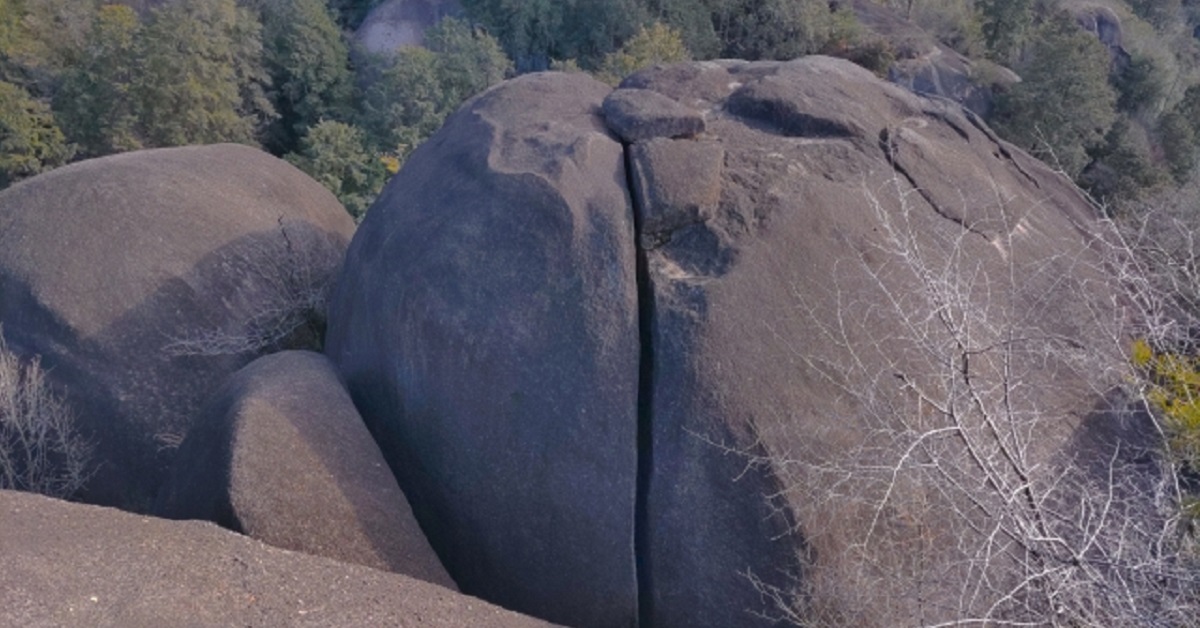Rengeiwa, a massive rock formation in Oniiwa Park in Gifu Prefecture, is also known as “Oni no Ittōiwa” (the Demon’s One-Slash Rock). Its sharp crack resembles a sword cut, reminding fans of the rock featured in Demon Slayer. This place is both a natural wonder and a pilgrimage destination for visitors seeking a link between anime and history.
What is Rengeiwa
Rengeiwa is the symbolic centerpiece of Oniiwa Park, famous for its huge vertical crack running through the middle. Standing several meters tall and wide, the rock overwhelms visitors with its size.
The fissure is believed to be the result of tectonic shifts and centuries of weathering, yet its neat and sharp appearance has inspired local legends claiming that a demon split the rock with a sword. For centuries, people have revered this site not only as a natural wonder but also as a spiritual object of faith.
Connection to Demon Slayer
In Demon Slayer, the protagonist must cut through a massive boulder during his training, a symbolic moment in his journey. The rock in the story is strikingly similar to Rengeiwa, which is why fans began referring to it as a pilgrimage site linked to the series.
When standing before the real rock, visitors are struck by its sharp crack and imposing presence, creating a powerful sense of stepping into the world of the story itself. This immersive feeling attracts young fans in particular, many of whom take photos and share them on social media.
Highlights of Oniiwa Park
Oniiwa Park is filled with giant stones and unique rock formations, offering well-maintained walking trails and seasonal beauty. Each visit offers a new way to enjoy its landscapes.
| Highlight | Feature | Seasonal Attraction |
|---|---|---|
| Rengeiwa (Oni no Ittōiwa) | A dramatic sword-like crack | Accessible year-round |
| Rock Formations | Granite weathered into unusual shapes | Awe-inspiring scenery |
| Cherry Blossoms | Rows of cherry trees | Best in spring |
| Autumn Foliage | Vivid red and yellow leaves | Best in autumn |
Legends and Historical Background
The name “Oniiwa” originates from local demon-slaying legends. According to folklore, a demon once terrorized the people until a brave warrior split the rock and defeated it. This tale gave rise to the name “Oni no Ittōiwa,” a story still passed down through generations.
The area has also long been associated with mountain worship and Shugendō practices, with rocks regarded as sacred. For locals, Rengeiwa is not only a natural wonder but also a holy site imbued with divine and demonic power.
Seasonal Ways to Enjoy the Park
Visiting Rengeiwa offers different experiences throughout the year.
| Season | Activity | Feature |
|---|---|---|
| Spring | Cherry blossoms with Rengeiwa as backdrop | The entire park becomes a flower-viewing spot |
| Summer | Hiking in cool forest shade | Refreshing streams and sound of water |
| Autumn | Photographing the rock with foliage | Stunning color contrasts |
| Winter | Viewing the snow-covered rock | A mystical, quiet atmosphere |
Each season reveals a new side of the park, making it a place worth visiting multiple times.
The Appeal of Pilgrimage
For Demon Slayer fans, Rengeiwa carries a deep symbolic meaning. Standing before the rock evokes the protagonist’s trial, allowing visitors to feel as if they themselves are part of the story.
Testimonials include remarks such as, “I felt like I was training alongside the character,” and, “The rock’s sheer power made it seem as though it really could be cut.” This sense of connection cannot be replicated through photos alone—it is an experience that holds value only on-site.
Access
Oniiwa Park is about 20 minutes by car from Mizunami City center, or 15 minutes from the Mizunami IC on the Chūō Expressway. Public transport is also available via bus from JR Mizunami Station, with a short walk from the park entrance.
| Transportation | Time | Notes |
|---|---|---|
| Car | About 15 min from Mizunami IC | Free parking available |
| Bus | About 30 min from JR Mizunami Station | Get off at park entrance |
| Walk | About 10 min from park entrance | Scenic walking trail |
Nearby Attractions and Things to Do
After visiting Rengeiwa, tourists can enjoy other spots nearby.
| Attraction | Feature | Travel Time |
|---|---|---|
| Minoyaki Ceramic Museum | Learn about Gifu’s traditional pottery | About 15 min by car |
| Obaachan Market & Roadside Station | Famous for Gohei-mochi and local produce | About 20 min by car |
| Hot Springs | Relax after hiking | Several options around the park |
These experiences, from culture to cuisine, enhance the overall trip and make the journey more fulfilling.
Conclusion
Rengeiwa is a miracle of nature carved by time and a pilgrimage spot for fans of Demon Slayer. Oniiwa Park as a whole is rich in history and scenery, drawing countless visitors who are captivated by its power and legends.
From seasonal landscapes and demon-slaying folklore to the thrill of pilgrimage and surrounding attractions, Rengeiwa offers a combination of experiences that few places can match. For fans, nature lovers, and history enthusiasts alike, it is a destination that leaves a lasting impression.






